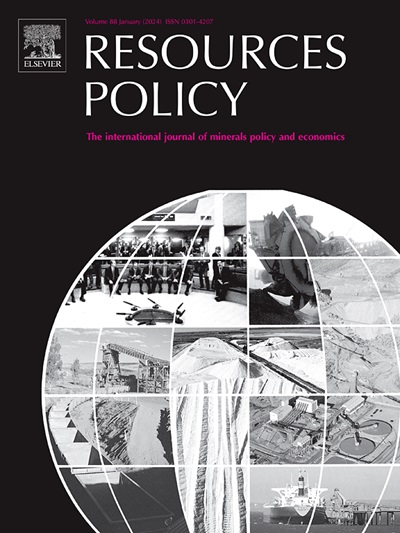The effect of economic sanctions on world trade of mineral commodities. A gravity model approach from 2009 to 2020
IF 10.2
2区 经济学
0 ENVIRONMENTAL STUDIES
引用次数: 0
Abstract
This article employs a gravity model to examine the impact of sanctions on the trade of mineral commodities, classified at a detailed level (using the six-digit code of the Harmonized System — HS, a global classification system for traded goods), from 2009 to 2020. The dataset covers flows from 239 exporter countries to 38 OECD members. The primary findings highlight that: (i) a significant trade disruption is evident, characterized by an immediate 90 percent reduction, with a growing impact observed over time; (ii) sanctions-busting appears effective only in the very short term, albeit with weak supporting evidence; (iii) sender countries experience a decline in trade not only with target countries but also with third countries (negative network effect).
An analysis by regions and commodity groups provides different evidence. First, North American sender countries exhibit the ability to replace imports from target countries with alternative suppliers, while EU countries experience a clear trade disruption. Second, when examining different mineral commodities, findings indicate that sanctions lead to a reduction in trade of Ores and Slag (HS Chapter 26) and Mineral Fuels and Oils (HS Chapter 27), but not in Salt and Cement (HS Chapter 25). Regarding sanctions-busting, it is evident for Ores and Slag. However, sender countries importing Salt and Cement seem to be able to shift to other sources, whereas sender countries importing Mineral Fuels and Oils experience a substantial trade disruption
经济制裁对世界矿产品贸易的影响。从2009年到2020年的重力模型方法
本文采用一个重力模型来研究2009年至2020年制裁对矿物商品贸易的影响,并对其进行了详细分类(使用协调制度(HS)的六位代码,这是一种全球贸易商品分类制度)。该数据集涵盖了从239个出口国到38个经合组织成员国的流动。主要研究结果强调:(1)明显的贸易中断,其特征是立即减少90%,随着时间的推移,影响越来越大;(ii)破坏制裁似乎只在极短的时间内有效,尽管支持证据不足;(三)出口国不仅与目标国的贸易下降,而且与第三国的贸易也下降(负网络效应)。按地区和商品类别进行的分析提供了不同的证据。首先,北美出口国表现出用其他供应商替代目标国家进口的能力,而欧盟国家则经历了明显的贸易中断。其次,在审查不同的矿产品时,调查结果表明,制裁导致矿石和矿渣(《HS》第26章)和矿物燃料和油(《HS》第27章)的贸易减少,但盐和水泥(《HS》第25章)没有减少。关于制裁的破坏,矿石和矿渣是显而易见的。然而,进口盐和水泥的输出国似乎能够转向其他来源,而进口矿物燃料和石油的输出国则经历了严重的贸易中断
本文章由计算机程序翻译,如有差异,请以英文原文为准。
求助全文
约1分钟内获得全文
求助全文
来源期刊

Resources Policy
ENVIRONMENTAL STUDIES-
CiteScore
13.40
自引率
23.50%
发文量
602
审稿时长
69 days
期刊介绍:
Resources Policy is an international journal focused on the economics and policy aspects of mineral and fossil fuel extraction, production, and utilization. It targets individuals in academia, government, and industry. The journal seeks original research submissions analyzing public policy, economics, social science, geography, and finance in the fields of mining, non-fuel minerals, energy minerals, fossil fuels, and metals. Mineral economics topics covered include mineral market analysis, price analysis, project evaluation, mining and sustainable development, mineral resource rents, resource curse, mineral wealth and corruption, mineral taxation and regulation, strategic minerals and their supply, and the impact of mineral development on local communities and indigenous populations. The journal specifically excludes papers with agriculture, forestry, or fisheries as their primary focus.
 求助内容:
求助内容: 应助结果提醒方式:
应助结果提醒方式:


